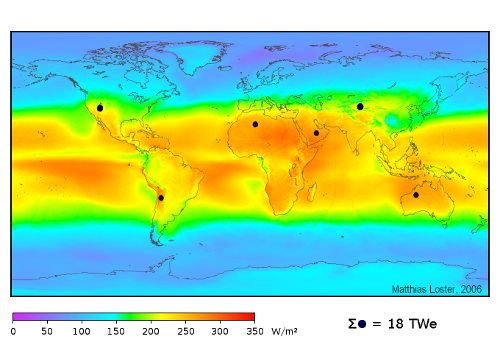Total Primary Energy Supply
— From Sunlight
 Sunlight hitting the dark discs could power the whole world: If installed in areas marked by the six discs in the map, solar cells with a conversion efficiency of only 8 % would produce, on average, 18 TW electrical power. That is more than the total power currently available from all our primary energy sources, including coal, oil, gas, nuclear, and hydro. The colors show a three-year average of solar irradiance, including nights and cloud coverage.
Sunlight hitting the dark discs could power the whole world: If installed in areas marked by the six discs in the map, solar cells with a conversion efficiency of only 8 % would produce, on average, 18 TW electrical power. That is more than the total power currently available from all our primary energy sources, including coal, oil, gas, nuclear, and hydro. The colors show a three-year average of solar irradiance, including nights and cloud coverage.
Total primary energy supply
The total primary energy supply (TPES) is the sum of all energy resources world wide, like coal, oil, gas, nuclear, and hydro. These resources are converted into gasoline, natural gas, electricity, and many other energy carriers. In 2007, the TPES was 504 Exajoule (EJ) or, on average throughout the year, 16 Terawatt (TW). The blue line in the graph below shows how the TPES has developed in the last decades.

The International Energy Agency (IEA) estimates that by 2030 the average TPES will be 23 TW based on current policies (red line), or 19 TW if policies currently under consideration will be introduced (green line). [1]
Harvesting sunlight
The energy of sunlight reaching the surface of the earth is more than 5,000 times the TPES. It is available directly as sunlight, as wind due to temperature differences, or as hydropower from rainfall of evaporated water. Several routes exist to directly convert sunlight into useful energy:
- Plants (via photosynthesis) => Biomass (low efficiency, needs water and soil)
- Solar thermal => Heat, Mechanic work (efficient, complex structures)
- Photovoltaics => Electricity (efficient, expensive)
Required land areas
If the TPES was to be generated entirely from sunlight, a certain amount of the earth's surface would be needed for capturing. The size of that area largely depends on the efficiency of the conversion technology. An example with a conversion efficiency of 8 % is shown in the figure at the top of this page: Six discs, each large enough to produce an average power output of 3 TW, are distributed across the world in deserts, areas that have plenty of sunlight and little population. The desert locations, their sizes, the average sunlight intensity, and the required areas are listed in the following table:
| Location / Desert |
Desert size
km2 [2] |
Required area
km2 |
Irradiance
W / m2 |
| Africa, Sahara |
9,064,960 |
144,231 |
260 |
| Australia, Great Sandy |
388,500 |
141,509 |
265 |
| China, Takla Makan |
271,950 |
178,571 |
210 |
| Middle-East, Arabian |
2,589,910 |
138,889 |
270 |
| South America, Atacama |
139,860 |
136,364 |
275 |
| U.S.A., Great Basin |
492,100 |
170,455 |
220 |
Distributed energy
While this example visualizes required land areas, it is better, in many cases, to generate energy closer to where it is needed. Roof tops of buildings and small solar farms are such places, saving transmission costs and, by interconnection, balancing periods of less sunshine.
Map data
The map at the beginning of this page, showing the spatially resolved solar irradiance, is based on an algorithm developed by Bishop and Rossow, [3] using data made available through the International Satellite Cloud Climatology Project (ISCCP), [4] which provides calibrated data collected by geostationary weather satellites around the world. The solar irradiance shown is a three year average from 1991 to 1993 and provides the total irradiance in a grid with 2.5° spacing in lattitude and longitude.
All data points are plotted in orthogonal lattitude and longitude coordinates. In consequence, distances, areas, and angles are increasingly distorted towards the poles. The coastline overlay was obatined from the National Geophysical Data Center (NGDC). [5]
Further reading
The Wikipedia article about Solar Energy has a thorough discussion of this topic:
http://www.wikipedia.org/wiki/Solar_energy
References
[1] International Energy Agency (IEA). "Key World Energy Statistics 2009." http://www.iea.org/
[2] Map of World Deserts. http://www.mapsofworld.com/world-desert-map.htm
[3] J. K. B. Bishop and W. B. Rossow. "Spatial and temporal variability of global surface solar irradiance." J. Geophys. Res. 96, 16839 (1991).
[4] International Satellite Cloud Climatology Project (ISCCP). http://isccp.giss.nasa.gov/
[5] National Geophysical Data Center (NGDC), NOAA Satellite and Information Service, Coastline Extractor. http://rimmer.ngdc.noaa.gov/mgg/coast/
Matthias Loster, 2010
|

